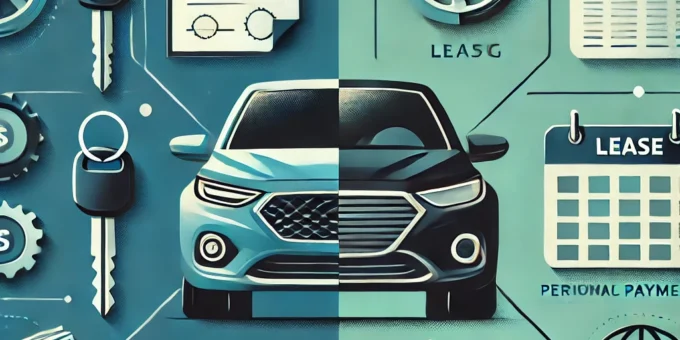
Car Financing vs. Leasing: Which Option is Right for You?
Purchasing a vehicle is one of life’s major financial decisions, and choosing between car financing and leasing can make all the difference in your experience of car ownership. While both options have their advantages, the right choice depends on your personal goals, budget, and driving habits. This comprehensive guide will explore the key differences between financing and leasing, outline their benefits and drawbacks, and help you decide which option best suits your needs.
What Is Car Financing?
Car financing is a process in which you borrow money, typically from a bank, credit union, or dealership, to purchase a vehicle. This involves taking out a loan that covers the cost of the car (minus any down payment) and paying it back over time, usually with interest.
With financing, you own the vehicle once the loan is fully repaid. The main appeal of car financing lies in ownership—your car becomes a long-term asset. While monthly payments may be higher than leasing payments, they contribute toward eventual ownership.
What Is Car Leasing?
Car leasing, on the other hand, is like renting a vehicle for a specified period, typically 2–4 years. Instead of paying toward ownership, you pay for the car’s depreciation during the lease term, plus interest and fees.
At the end of the lease, you return the car to the dealership or leasing company. In some cases, you may have the option to buy the car for its residual value. Leasing is ideal for drivers who enjoy having a new vehicle every few years without the hassle of ownership.
Key Differences Between Financing and Leasing
| Aspect | Car Financing | Car Leasing |
|---|---|---|
| Ownership | You own the car after the loan is paid off. | You do not own the car; must return it after the lease term. |
| Monthly Payments | Higher payments but contribute to ownership. | Lower payments but no equity is built. |
| Mileage Limitations | Unlimited miles; no restrictions. | Typically 10,000–15,000 miles per year; excess miles cost extra. |
| Wear and Tear | No penalties for normal wear and tear. | Must adhere to wear-and-tear policies; penalties apply for excess damage. |
| Customization | Free to modify the car as desired. | Modifications are generally not allowed. |
| Upfront Costs | Down payment and loan fees required. | First month’s payment, security deposit, and fees. |
| End of Term | You keep the car. | Return the car or buy it at the residual value. |
Understanding these differences can help you weigh your options more effectively.
Benefits of Car Financing
- Ownership: Once the loan is paid, the car is yours to keep.
- No Mileage Restrictions: Drive as much as you want without penalty.
- Freedom to Customize: Add accessories, upgrade features, or modify the car to suit your preferences.
- Asset Value: The car retains some resale or trade-in value.
- Long-Term Savings: Financing can be more cost-effective over time, especially if you keep the car for many years.
Car financing is best for those who want to invest in long-term vehicle ownership and prefer no limitations on mileage or customization.
Benefits of Leasing a Car
- Lower Monthly Payments: Leasing usually costs less per month than financing.
- Newer Models: Drive a brand-new car every few years without committing to ownership.
- Lower Upfront Costs: Initial payments for leasing are typically lower than financing down payments.
- Warranty Coverage: Most leased cars remain under warranty throughout the lease term, reducing repair expenses.
- Simplified Returns: At the end of the lease, you can return the car and walk away or choose a new lease.
Leasing is ideal for those who prioritize driving a newer car every few years and don’t want the responsibilities of ownership.
Mileage Restrictions
When you lease a car, mileage limitations are one of the biggest drawbacks. Exceeding the limit (usually 10,000–15,000 miles per year) can lead to costly penalties, often ranging from $0.10 to $0.25 per mile.
In contrast, financing a car comes with no mileage restrictions, making it a better option for drivers who cover significant distances annually.
Tax Benefits for Leasing vs. Financing
For business owners, leasing can offer significant tax advantages. Lease payments may be partially or fully deductible as a business expense, depending on the car’s usage.
With financing, only the depreciation and interest portion of the car’s cost may be deductible, and only if the vehicle is used for business purposes. Consulting a tax professional can help you determine which option offers better savings based on your situation.
Steps to Decide Between Leasing and Financing
- Assess Your Budget: Determine how much you can afford monthly.
- Evaluate Your Driving Habits: Consider mileage, wear and tear, and how long you plan to keep the car.
- Research Models and Costs: Understand the costs of leasing versus financing your preferred car.
- Get Quotes: Compare offers from dealerships, banks, and leasing companies.
- Weigh Pros and Cons: Factor in your priorities—ownership, flexibility, or lower monthly payments.
FAQs About Car Financing and Leasing
Can I buy the car at the end of a lease?
How do interest rates differ between financing and leasing?
What happens if I want to terminate my lease early?
Are maintenance costs included in lease agreements?
Can I lease a used car?
What credit score is required for leasing versus financing?
The decision between car financing and leasing ultimately boils down to your financial goals and lifestyle. Financing is the better choice for long-term ownership and unrestricted use, while leasing appeals to those who prefer lower monthly payments and driving the latest models. By weighing the pros and cons, comparing offers, and assessing your needs, you’ll be ready to make the choice that’s right for you. Whatever you decide